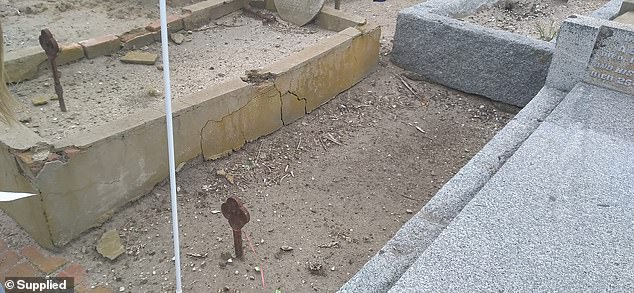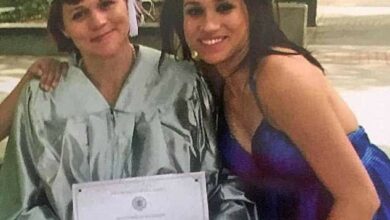The tragic story of Australia’s ‘forgotten soldier’ and one man’s fight to have him recognised

Discarded war medals found on the street led to the discovery of the unmarked grave of a First World War soldier, lost and forgotten for almost a century.
The remarkable piecing together of William McEwan’s tragic story has also fueled the fight to give him and hundreds of other forgotten Australian war heroes the official posthumous recognition their sacrifice deserves.
‘Our William was an ordinary guy from an ordinary family who went and ‘did his bit’ like so many Aussies, but unfortunately came back physically and mentally broken,” Melbourne military history enthusiast Peter Zabrdac told Daily Mail Australia.
‘It is disgusting that his grave was never properly marked and forgotten for 99 years. I am determined to get him the military gravestone he deserves.”
Mr Zabrdac’s father found William’s discarded medals on a Fitzroy street in inner-city Melbourne in the early 1970s.
Although they fascinated Mr. Zabrdac, who was in primary school at the time, he forgot about them until he found the military honors among his father’s belongings earlier this year.
Mr Zabrdac, now 59 and a semi-retired company director, did some research which led him to retrieve William’s entire 79-page “beautifully handwritten” army file from the National Archives in Canberra.
“The more I read his file, the more human he became,” Zabrdac said.

The unmarked and long-lost grave of William McEwan, a seriously wounded World War I Digger who fought for Australia

William McEwan was so badly wounded in the battle for the French town of Pozieres in 1916 that the army wrote to his mother that he was unlikely to survive.
William was only 1.63 meters tall, which initially prevented him from registering for Gallipoli.
After that disastrous campaign and other battles, the Australian army was forced to lower its height minimums to replenish its numbers, which meant William was able to enlist and he was sent to fight in France.
During the hellish four-month battle for the French village of Pozieres in 1916, where the Germans unleashed their full arsenal, including phosphorus shells and poison gas, William joined the 23,000 Australian casualties, with 6,800 killed or mortally wounded.
William was shot through both lungs and arms and received shrapnel in his back.
“He was not expected to live and his poor mother was informed of this by the army,” Mr Zabrdac said.
‘How he lived only God knows.’
William was evacuated to England, where he recuperated for 18 months before being discharged in 1917 as unfit for further service.
William returned to Melbourne and married, but DrIn 1923 he took his own life amatically and publicly.
An obituary from the now defunct Melbourne newspaper The Argus stated that William walked into a pub in Brunswick, near Fitzroy where he lived, and told the bartender to serve him “a pint of poison” and gave him a ‘bob’ had to borrow (12 pence in advance). decimal currency).

One of William’s medals was apparently discarded on a Fitzroy street in the early 1970s
When this ‘unusual request’ was refused, William ordered a beer instead, which he drank, but then walked out into the street and ‘drank some poison and staggered into the garden of the hotel, where he died’.
“He had been suffering from chest problems since returning from the war,” The Argus reported.
Mr Zabrdac said that with the help of Faith Jones from the Virtual War Memorial group and Lois Comeadow from the Brighton Cematorians, he was able to locate not only a living relative of William but also the war hero’s grave.
However, Mr Zabrdac was shocked and dismayed when William lay anonymously in an unmarked burial ground at the Brighton Cemetery, located in Melbourne’s south-eastern suburb of Caulfield South.
‘“Our William was an ordinary guy from an ordinary family who went and ‘did his bit’ like so many Aussies, but unfortunately came back broken physically and mentally,” Mr Zabrdac said.
“It is disgusting that his grave was never properly marked and forgotten for 99 years, and I am determined to get him the military headstone he deserves.

The extraordinary 1923 obituary for William, included in his army file from the now defunct Melbourne newspaper The Argus
Mr. Zabrdac has learned that the Department of Veteran Affairs will only designate William as eligible for a war grave and provide a ceremonially engraved headstone valued at approximately $7,000 if it can be proven that he died of battlefield wounds.
“All we have so far is the statement taken by the police from his landlady in which she stated that he was ‘terribly suffering from respiratory problems,’” Mr Zabrdac said as he prepared a statement.
Mr. Zabrdac pointed out that families of American veterans are always given a special place to honor their deceased loved ones.
“The Americans have Arlington Military Cemetery (in Washington) for their returning soldiers, yet we do nothing in Australia and that is shameful,” he said.
‘There are many other Diggers across Australia in similar situations, forgotten and lying in unmarked graves.’

Peter Zabrdac (pictured left) attends a flag ceremony at William’s grave with Victoria RSL State Committee member Ange Kenos
Mr Zabrdac attended a flag-raising ceremony at William’s grave last Friday, which also included ADF members and Victorian RSL representatives.
He said the heartfelt ceremony was just the beginning of the effort to honor William, with all those present pledging not to rest until they found a headstone or plaque for this previously unrecognized soldier.
Mr Zabrdac also plans to give William’s medals to the only surviving relative he has managed to track down, Wendy Newman, who lives in Queensland.
Between 1997 and 2021, there were 1,677 confirmed suicides by incumbent and ex-incumbent ADF members, representing 20 times the number of deaths in armed conflict during that period.
The Department of Veterans’ Affairs has been contacted for comment.




